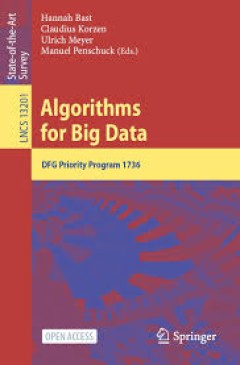Filter by

Autonomous Control for a Reliable Internet of Services: Methods, Models, Appr…
This open access book was prepared as a Final Publication of the COST Action IC1304 “Autonomous Control for a Reliable Internet of Services (ACROSS)”. The book contains 14 chapters and constitutes a show-case of the main outcome of the Action in line with its scientific goals. It will serve as a valuable reference for undergraduate and post-graduate students, educators, faculty members, res…
- Edition
- 1
- ISBN/ISSN
- 9783319904153
- Collation
- XVI, 401
- Series Title
- -
- Call Number
- -

Algorithms for Big Data: DFG Priority Program 1736
This open access book surveys the progress in addressing selected challenges related to the growth of big data in combination with increasingly complicated hardware. It emerged from a research program established by the German Research Foundation (DFG) as priority program SPP 1736 on Algorithmics for Big Data where researchers from theoretical computer science worked together with application …
- Edition
- 1
- ISBN/ISSN
- 9783031215346
- Collation
- XIV, 285
- Series Title
- -
- Call Number
- -

Cybersecurity of Digital Service Chains: Challenges, Methodologies, and Tools
This open access book presents the main scientific results from the H2020 GUARD project. The GUARD project aims at filling the current technological gap between software management paradigms and cybersecurity models, the latter still lacking orchestration and agility to effectively address the dynamicity of the former. This book provides a comprehensive review of the main concepts, architecture…
- Edition
- 1
- ISBN/ISSN
- 9783031040368
- Collation
- XI, 257
- Series Title
- -
- Call Number
- -

Participative Urban Health and Healthy Aging in the Age of AI: 19th Internati…
This open access book constitutes the refereed proceedings of the 18th International Conference on String Processing and Information Retrieval, ICOST 2022, held in Paris, France, in June 2022. The 15 full papers and 10 short papers presented in this volume were carefully reviewed and selected from 33 submissions. They cover topics such as design, development, deployment, and evaluation of AI f…
- Edition
- 1
- ISBN/ISSN
- 9783031095931
- Collation
- XI, 312
- Series Title
- -
- Call Number
- -

Participative Urban Health and Healthy Aging in the Age of AI
This open access book constitutes the refereed proceedings of the 18th International Conference on String Processing and Information Retrieval, ICOST 2022, held in Paris, France, in June 2022. The 15 full papers and 10 short papers presented in this volume were carefully reviewed and selected from 33 submissions. They cover topics such as design, development, deployment, and evaluation of AI f…
- Edition
- 1
- ISBN/ISSN
- 978-3-031-09593-1
- Collation
- -
- Series Title
- Lecture Notes in Computer Science
- Call Number
- XI, 312

Facebook Democracy : The Architecture of Disclosure and the Threat to Public …
Drawing on a number of disciplines and an ethnographic analysis of 250 Facebook political groups, Marichal explores how Facebook's emphasis on social connection impacts key dimensions of political participation: e.g. mobilization, deliberation, and attitude formation.
- Edition
- -
- ISBN/ISSN
- 9781315581798
- Collation
- -
- Series Title
- -
- Call Number
- 650

Spectrum Sharing for Wireless Communications
This SpringerBrief presents intelligent spectrum sharing technologies for future wireless communication systems. It explains the widely used opportunistic spectrum access and TV white space sharing, which has been approved by the FCC. Four new technologies to significantly increase the efficiency of spectrum sharing are also introduced. The four technologies presented are Dynamic Spectrum Co-Ac…
- Edition
- -
- ISBN/ISSN
- 978-3-319-13803-9
- Collation
- -
- Series Title
- -
- Call Number
- -

Cybersecurity of Digital Service Chains
This open access book presents the main scientific results from the H2020 GUARD project. The GUARD project aims at filling the current technological gap between software management paradigms and cybersecurity models, the latter still lacking orchestration and agility to effectively address the dynamicity of the former. This book provides a comprehensive review of the main concepts, architecture…
- Edition
- 1
- ISBN/ISSN
- -
- Collation
- -
- Series Title
- Lecture Notes in Computer Science
- Call Number
- XI, 257

Spectrum Trading in Multi-Hop Cognitive Radio Networks
This SpringerBrief focuses on spectrum trading designs in multi-hop cognitive radio networks. It starts with the motivation for spectrum trading and the review of existing spectrum trading designs. Then, it presents a novel CRN architecture for spectrum trading considering spectrum trading’s economic features and wireless nature. Under this network architecture, it extends current single-hop …
- Edition
- -
- ISBN/ISSN
- 978-3-319-25631-3
- Collation
- -
- Series Title
- -
- Call Number
- -

Spectrum Sharing for Wireless Communications
This SpringerBrief presents intelligent spectrum sharing technologies for future wireless communication systems. It explains the widely used opportunistic spectrum access and TV white space sharing, which has been approved by the FCC. Four new technologies to significantly increase the efficiency of spectrum sharing are also introduced. The four technologies presented are Dynamic Spectrum Co-Ac…
- Edition
- -
- ISBN/ISSN
- 978-3-319-13803-9
- Collation
- -
- Series Title
- -
- Call Number
- -
 Computer Science, Information & General Works
Computer Science, Information & General Works  Philosophy & Psychology
Philosophy & Psychology  Religion
Religion  Social Sciences
Social Sciences  Language
Language  Pure Science
Pure Science  Applied Sciences
Applied Sciences  Art & Recreation
Art & Recreation  Literature
Literature  History & Geography
History & Geography